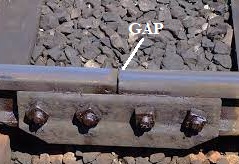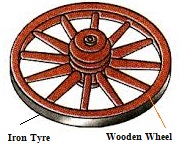Science > Physics > Thermal Properties of Matter and Thermodynamics > Applications of Expansion of Solids
Linear expansion or longitudinal expansion refers to the increase in length of a solid material when its temperature rises. This phenomenon occurs due to the increased thermal energy within the material, causing its constituent particles to vibrate more vigorously, thereby increasing the average distance between them. Understanding the linear expansion is crucial for predicting and engineering the thermal behaviour of materials in various applications, including construction, manufacturing, and thermal management systems.
LIST OF SUB-TOPICS:
- Applications of Linear Expansion of Solids
- Applications of Superficial Expansion of Solids
- Applications of Cubical Expansion of Solids
Applications of Linear Expansion of Solids:
A gap is kept between two successive rails
The rails of a railway expand in summer and contract in winter. Therefore gaps are kept between successive rails to allow for their expansion. The gap allows the rails to expand without exerting excessive force on the structure.

If there are no gaps, the increase in temperature will cause the rails to expand and they will overlap one another or dislodge from the position. This will be dangerous to the trains and may result in a severe accident. If the rails were tightly connected without any gap, thermal expansion could cause bending, buckling, or even structural damage.

To put an iron tyre on a wooden wheel of bullock cart, the iron tyre is heated first
Putting an iron tyre on a wooden wheel of a bullock cart involves a process known as “shrinking” or “setting” the tyre onto the wheel.
The diameter of the iron tyre is always slightly less than the wooden wheel of the bullock cart. Heating the iron tyre causes it to expand due to thermal expansion. As the temperature increases, the diameter of iron tyre. This expansion makes the iron tire slightly larger in diameter. Hence the tyre easily slides over the wooden wheel of the bullock cart. Then water is poured on the red-hot tyre. It contracts and grips the wheel firmly.

The clocks regulated with pendulum require adjustment during summer and winter.
The pendulums of clocks expand in summer and contract in winter, therefore, they lose time in summer and gain time in winter. In order that the clocks should give correct time, the pendulums are made from invar which is an alloy having a very small coefficient of linear expansion in some clocks, compensating pendulums are used.
A compensating pendulum is made of a number of iron and brass rods joined in such a way that the length of the pendulums remains constant even if there is a change in temperature. Such clocks show accurate time. If this is not possible the clocks require the adjustment in summer and winter.
Bimetallic strips are used as temperature controlling devices.
The bending of the bimetallic strip is due to the difference in the coefficient of linear expansion of two different metals used in the bimetallic strip.

A bimetallic strip consists two strips of different metals fixed to each other lengthwise An increase in temperature causes bending of the strip in such a way that the metal of greater linear coefficient of expansion lies on the outer side. A lowering of temperature again bends the strip, but with the metal of smaller linear coefficient of expansion on the outer side. Such strips can be used in electric iron, electric oven, refrigerators to control the temperature.
When the hot glass of a lamp is touched with a cold knife, it sometimes cracks.
When the hot glass of a lamp is touched with a cold knife, the part of the glass, which is in contact with the knife contracts. Due to this local contraction, While remaining portion remains in the expanded condition. Due to uneven expansion in the glass, the glass cracks. This phenomenon is known as thermal shock.
When hot milk is poured into a thick-walled glass vessel it cracks.

When milk is poured into a thick-walled glass vessel at room temperature, the inner surface of the vessel gets expanded, while the outer surface remains at room temperature. Thus there is no expansion on the outer surface. Due to uneven expansion in the vessel, the glass cracks. This phenomenon is known as thermal shock.
The unit of the coefficient of expansion the same for linear, superficial as well as a cubical expansion:
The coefficient of expansion is the ratio of two similar quantities divided by temperature. Therefore, its unit is the same as the reciprocal of the unit of temperature for any kind of expansion.
If the temperature is measured on the Celsius scale the unit is per degree Celsius and if the temperature is measured on the Kelvin scale, the unit is per degree Kelvin.
Other Applications:
- Telephone and electric wires are arranged little bit loosely between any of the two poles. It is simply because with the decrease in temperature in winter season, the wire contracts and if they were arranged tightly that will become further tight and they may break. To avoid this problem, they were arranged loosely.

- Iron or steel girders are used in the construction of a bridge. One end of the girder is rigidly fixed with bricks and concrete. The other end is not fixed. Instead, the end is set on a roller over the support. When there is rise or fall in temperature due to seasonal changes, girders may expand or contract, without developing any thermal stress.

- In construction and engineering, materials like concrete, steel, and asphalt expand and contract with temperature changes. Expansion joints are used to allow for these movements without causing damage to structures. For example, bridges, buildings, and pipelines incorporate expansion joints to accommodate thermal expansion and contraction.

Applications of Superficial Expansion of Solids:
Removing Tight Lids of Glass Jar:
To open the lid of a glass jar that is tight enough, it is immersed in hot water for a minute or so. Metal cap expands and becomes loose. It would now be easy to turn it to open.
The high-temperature water causes the metal lid and glass jar to expand. But the glass has a low coefficient of expansion than the material of the lid. Hence the lid expands more than the glass jar and the lid can be easily removed.
To Pass a Nail Through Hole in Metal Plate:
To pass nail through a metal plate having a hole of a diameter slightly less than that of the nail, the plate is heated. so that the diameter of hole increases and the nail can easily pass through it.
Applications of Volumetric Expansion of Solids:
Use of Mercury or Alcohol in Thermometer:
A thermometer measures temperature by measuring a temperature-dependent property. Expansion of liquid is the temperature-dependent property and they are in direct proportion. Thus measuring the change in volume of mercury we can find the change in temperature.
Mercury has a high boiling point, and a highly predictable and shows a uniform response to changes in temperature. Mercury has a very high coefficient of volumetric expansion than the glass. Hence expands at a faster rate than glass. The expansion of the glass is negligible.
In a typical mercury thermometer, mercury is placed in a long, narrow sealed tube called a capillary. Because it expands at a much faster rate than the glass capillary, the mercury rises and falls with the temperature. A thermometer is calibrated with one of the temperature scales.
Riveting of two Metal Plates:
Two steel plates can be jointly tightly together by a process called riveting. Rivets are heated to red hot condition and are forced through coaxial holes in the two plates. The end of hot rivets is then hammered and shaped. On cooling, the rivets contract and bring the plates tightly gripped to each other.

Design of Air Craft:
The aircraft expands by 15-25centimetress during its flight due to the increase in temperature on account of heat created by friction with the air. Designers used rollers (separators) to isolate the cabin and passenger area from the body of the aircraft so that the expansion does not rip the plane apart.
Overflow Tanks of Coolant in Automobiles:
The efficiency of an internal combustion engine depends on heat rejected to the surroundings. Thus efficient cooling of the engine ensures the efficiency of the engine. Coolants are used to cool the engine. But during the process coolant itself undergoes volumetric expansion. If overflow tanks are not provided, there is a possibility of the bursting of coolant line. Hence automobiles have coolant overflow tanks.
Use of Thick Bottles for Soft Drinks:
To avoid bursting of soft drink bottles containing gas, due to thermal expansion, their walls are made very thick.
Conclusion:
The expansion of solids, which refers to the increase in size or volume of a material in response to changes in temperature, has several practical applications across various fields. Understanding the principles of thermal expansion allows engineers and designers to develop systems and structures that can accommodate temperature changes and operate reliably in various environments.
For More Topics in Thermal Properties of Matter and Thermodynamics Click Here
One reply on “Applications of Expansion of Solids”
this content is very good and should be expanded next time.